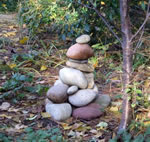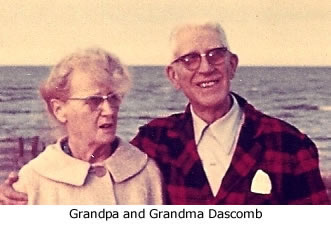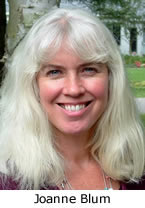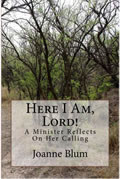 |
||
|
||
| Cairns And Wellsprings | ||
| —Joanne Blum . | ||
Joe and I were hiking in Sedona, Arizona, taking a much-needed break from my job as a church pastor (and his unofficial job as associate pastor), when we stumbled upon one of those piles of stones people use to mark a path. It’s the minister in me, I suppose—and the attraction to signs and wonders that comes with the calling—but I love a cairn. The trail we were on was so remote, that the appearance of this one was surprising. But then I’ve seen cairns in places as far-flung as Northern Ireland and upstate New York. Every time I discover one, I find myself musing about why we do it. I’m pretty certain we don’t build them just to get our geographical bearings. We humans like landmarks and guideposts of all kinds—not just to point the way physically, but to direct us mentally, emotionally, and spiritually. I do anyway. My love of cairns has to do with my love of guidance. We leave these signs for each other in both tangible and intangible ways. Whenever someone shares a bit of hard-earned wisdom with me, I get a similar feeling of having stumbled on a cairn to help me avoid a few pitfalls and make my path a little smoother. I think of these as idea cairns. They’re the kind that arise every time we make a discovery about life and decide to pass it along to someone else. The discovery doesn’t have to be big. Maybe it’s just a new idea about something, or a reminder that we’re doing okay and a major over-haul isn’t necessary after all. I’ve gotten cairns like that. I remember my friend Rose, a master gardener, helping me plant a redbud tree in my front yard. Worrying aloud over the hard soil full of rocks and roots, I vigorously worked in the peat. “It’s a wonder we can grow anything in this dense clay,” I said. “Don’t make the dirt too nice,” Rose responded. “This clay is what it’s meant to grow in, after all.” Now there’s a cairn for you. A lesson learned and shared—about not going overboard to make things right, about remembering that however difficult things seem, we’re in our natural element and there’s no reason we can’t flourish here. I’m grateful for that little touchstone, as I am for so many I’ve received. One of my earliest and best touchstones was a gift from my grandfather, William Dascomb, who had a tree farm in upstate New York. As a child I spent two or three weeks there every summer swimming in the pond, picking raspberries, and playing kick the can with my cousins. One afternoon my younger cousin, Karen, and I were playing on the rope swing in the front yard when Grandpa Dascomb called us to come join him. He had just finished raspberry picking and was heading into the field across the road. “Come on, girls, I want to show you something,” he said, launching out into the waist-high weeds. We hopped and ran to catch up with his big steps, not talking or singing as we usually did, but walking quickly and quietly, knowing this was important. Reaching a lush green thicket in the middle of the field, he pushed aside the shrubbery to reveal a small opening in the ground, with a lot of stones piled up around it, and a glint of water within. “Look!” he said, pointing at the ground. “Do you see it?” he asked, meeting our eyes to make sure. We nodded, as if we understood, and then he told us we could go on back to the swing. We ran off, happy to resume our swinging, but feeling a sense of dignity that hadn’t been there before, like we’d been entrusted with a secret, which we had—we’d learned the location of one of the three natural springs that dotted the farm. It would be a while before we found the other two, or came to understand why they mattered. If anyone knew about hidden springs, it was Will Dascomb. The natural springs on the farm had a lot to do with why he bought that 150-acre parcel back in 1914. They amply filled the pond he dug by hand, with horse, hoe, and shovel. Other farms nearby had empty pond basins that water never graced, but my grandfather knew those springs would keep his pond fresh and full for the rest of his days. He knew even more about the springs of heart and home. Chief among these was his marriage to Mildred Belle, the beauty of the county he’d won and wed back in 1915, and whom he’d slept beside in the same narrow bed for more than 50 years. Then there was his relationship with his “Maker,” whom he prayed to every night, on his knees by the bed alongside Millie, talking to God like a trusted friend and benefactor, which I guess he was, since with a remarkable grace, my grandfather managed to ease his wife and four children through the Depression, two world wars, and physical threats ranging from rattlesnake bites, to influenza and tuberculosis. When Grandpa Dascomb had the stroke and was paralyzed down the left side and had to sleep in a hospital bed in the next room, Grandma was still at his side, needing help only for the lifting, from bed, to chair, to commode, guiding him through the last two years of his life steadily and serenely, without ever appearing burdened by his care.
From where I stand now—pastoring a small church in Ohio—it’s clear to me what my grandfather was doing when he interrupted his work that summer afternoon to show his youngest granddaughters a spring hidden in a field. He was telling us it’s important to know where the wellsprings are in your life. In a way it’s the same thing ministers are called to do—point out the sources of strength and renewal we’ve been able to discover in our lives, in hopes that they might be helpful to others. Thinking of my cousin Karen, who is a minister now too, serving a small church in rural New York, and my sister Nancy with a church in California, and my other cousins who work as counselors, social workers, or teachers, I can’t help but marvel at the ripples widening out from that sharing of springs—not just the springs on the farm, but the farm itself, and my grandfather, and all my family, and the sweet green world we got the chance to inhabit during those summer weeks so many years ago. We found springs and touchstones to last a lifetime, and to feed a multitude of ministries. I’ve come to realize how impossible it is to draw a sharp dividing line between one person’s gift and another’s. The ripples flow out in so many directions at once. Rose’s lesson about how things grow: where did she get it except from the guidance of other gardeners and from watching things grow in her own yard year after year? And Grandpa Dascomb, how did he learn about the hidden wellsprings of a life, except from dipping into the springs of those who came before him? It’s hard to track a point of origin for these cairns of truth and wellsprings of wisdom. “Faith is a flowing,” wrote the Sufi poet Rumi, some nine centuries ago. Perhaps he was talking about the way these truths circulate among us. Every time a portion of wisdom is shared, our collective wisdom stretches out farther, turning eventually into a wide river of truth flowing through the world that people can drink from and be refreshed by. Faith flows in us, in other words, and among us, and beyond us, as we speak our truths to one another in the hope they will be useful. Why does anyone warn of a danger, point to a spring, or make a cairn, after all, if not to help someone else along? I think it’s a kind of spiritual survival urge, perhaps an undiscovered part of our DNA, that compels us to share the wisdom we’ve learned from each other—because we’re not meant to go it alone, learning hard survival lessons again and again, but to help each other along so human progress can be made steadily, with fewer lapses into misery and chaos. We have a “shared aliveness,” as Brother David Steindl-Rast puts it. We are fellow travelers, making our way along tricky terrain, and if by grace one of us finds a way through a perilous pass, a minefield, or a wilderness, we are obliged to let others know about it. This is what ministers are called to do, it seems to me, whatever we might actually do for a living, and however our talents may run.
Ministry is more an attitude than an occupation, and it’s work you never really quit, even in the face of illness or advancing age. You just find other ways to do it. Whatever our background, whatever our degrees, denominations, or abilities, ministers share a common feeling that it isn’t enough to find our own way through dark and difficult times, but that we must somehow light a path, reveal a wellspring, or stack up a pile of stones to make someone else’s way a little easier. Excerpt from Here I Am, Lord! A Minister Reflects on Her Calling, by Joanne Blum Available from Amazon.com in paperback and digital editions. |
||
|
||
| Don't miss another copy of Science of Mind magazine. |


 Ministry, to my mind, is a calling without boundaries or tenure. So many of the people I know are ministers—some as church pastors, but others as musicians, teachers, artists, writers, and a dozen other occupations. They may not think of their work as ministry, but it is. You can tell by the devotion they bring to it, and by the way they do their work, as if the merit of their lives depends on it.
Ministry, to my mind, is a calling without boundaries or tenure. So many of the people I know are ministers—some as church pastors, but others as musicians, teachers, artists, writers, and a dozen other occupations. They may not think of their work as ministry, but it is. You can tell by the devotion they bring to it, and by the way they do their work, as if the merit of their lives depends on it. 